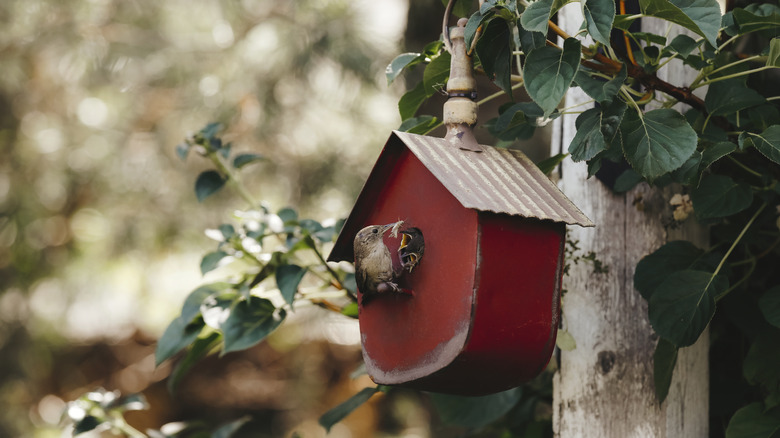Whether you’re an old pro at birding or just getting involved in the hobby, you’ll want to hang a birdhouse in your yard in the best place possible to attract the most colorful visitors. Surveying your yard for a tree or structure where you can attach a birdhouse is the first step. You’ll want to take the direction it will be facing and the appropriate height into consideration to locate the perfect spot. As you might suspect, putting a birdhouse in a location where it won’t get too much direct sun and blowing rain is a good idea. That usually means placing your birdhouse so it faces somewhere between north and east. In other words, you want to face the hole in your birdhouse in the opposite direction of prevailing winds, and in a spot shaded during the hottest parts of the day.
The height of your birdhouse will depend on the type of birds you want to attract. For instance, wrens and robins prefer houses no more than 6 1/2 feet in height while woodpeckers like houses 10 to 16 feet from the ground. There are also some other helpful hints regarding where to hang birdhouses, and what to avoid.
More on choosing the perfect location for a birdhouse

If you’re not getting as many tenants in your birdhouse as you’d like, the area you’ve chosen for it could be deterring feathered friends from your yard. Even if it’s in a seemingly perfect location facing between north and east, birds don’t typically want to nest in a high-traffic area. That means locating houses away from feeders and birdbaths that see lots of activity. Feeders can also draw other animals that might threaten both eggs and young birds like squirrels, raccoons, and snakes. This causes most nesters to look elsewhere for a place to hatch their young.
Some birds like common grackles are also predators for eggs, younglings, and small fully grown birds such as sparrows. If they’re often seen frolicking in your birdbath, that’s also a deterrent to the feathered friends you would like to host in your birdhouse. Different species of birds also have more specific location preferences for houses. For instance, bluebirds and swallows tend to choose birdhouses that are out in the open. Robins and wrens frequent birdhouses hidden in vegetation. Woodpeckers, not surprisingly, prefer their houses to be attached to the trunk of a tree.
Mistakes to avoid when locating a birdhouse
Chances are, you’ve seen many birdhouses suspended from tree branches or dangling from porches. That’s fine for decorative birdhouses, but not ones you really want birds to live in. Why? Birds don’t like houses that swing back and forth in the breeze. It’s preferable to mount them on a structure, tree, or even a metal pole — a metal pole can actually be a great choice since they’re hard for predators to climb and you can adjust the birdhouse placement and height more easily depending on the birds you’re wanting to attract. They do, however, need to be secured in the ground to deter movement.
It’s also better in many instances to space birdhouses out rather than clustering them together since most birds seek privacy when raising a family. In fact, wrens will stuff twigs and other nesting material in unused houses near their own to discourage other birds from using them. The exception is with martins and both house and tree sparrows since they are colonial nesting birds. With a little forethought about the type of birds you’d like to host, you can select the perfect spot for a birdhouse that will attract more birds to your yard and garden.